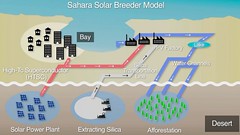In truth, there are multiple methods of storing energy from daytime sunlight or windy days. One particularly good example is the Bath Country Hydro Pumped Storage Facility, operated by Dominion Power on the Virginia-West Virginia border. Energy stored as hydropower in one of the largest engineering projects ever implemented helps serve the energy needs of some 60-million people across 13 states.
A Think Progress article on the topic included this quote:
When Sean Fridley, the facility’s Station Manager, looks at the Upper Reservoir perched a thousand feet above his office, he doesn’t see drops of water. He sees a thousands-of-megawatts-deep block of power, a huge amount of stored potential energy — with more output than the Hoover Dam — that he can turn on with a flick of a switch.Other innovative storage methods have been suggested, all based on proven technologies. A promising plan was presented in Scientific American in 2007 involving collection of solar energy in the US southwest desert, with distribution over high-voltage DC transmission lines to compressed-air storage facilities around the country. The current cost of compressed-air storage is roughly half that of lead-acid batteries.
This video gives a nice overview of the storage facility in Bath County:
The next time someone tells you that intermittent energy sources can't solve our energy needs, the evidence is abundant that they don't know half the story.


















